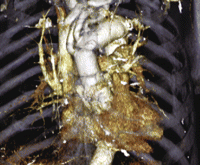-
PDF
- Split View
-
Views
-
Cite
Cite
Yoshiharu Nishimura, Yoshitaka Okamura, Shunji Uchita, Kentaro Honda, Abrupt rupture of an aortic arch aneurysm into the pulmonary artery, European Journal of Cardio-Thoracic Surgery, Volume 36, Issue 1, July 2009, Pages 212–213, https://doi.org/10.1016/j.ejcts.2009.03.007
Close - Share Icon Share
Abstract
We report an extremely rare case of pulmonary artery dissection caused by an abrupt rupture of an aortic arch aneurysm into the pulmonary artery. An asymptomatic 80-year-old man was admitted to our hospital for elective surgical repair of aortic arch aneurysm. After admission, sudden onset of hoarseness and dyspnea developed. Echocardiography demonstrated an intimal flap in the pulmonary artery and abnormal shunt flow from aortic arch aneurysm into the pulmonary artery. At surgery, the pulmonary artery dissection involved the main pulmonary artery and both major branches. Total arch replacement and pulmonary artery reconstruction were successfully performed.
1 Introduction
Pulmonary artery dissection without underlying pulmonary artery hypertension is an extremely rare condition [1]. We report a case of pulmonary artery dissection caused by an abrupt rupture of aortic arch aneurysm successfully repaired by total arch replacement and pulmonary artery reconstruction.
2 Case report
The patient was an 80-year-old man with asymptomatic aortic arch aneurysm. Computed tomography (CT) demonstrated an aortic arch aneurysm with a maximum diameter of 70 mm. The patient was admitted to our hospital for elective total arch replacement. However, 2 days after admission, sudden onset of dyspnea and hoarseness developed and chest auscultation demonstrated continuous cardiac murmur that had not been detected previously. Echocardiography demonstrated an intimal flap floating in the pulmonary artery. An abnormal shunt flow from the aortic arch aneurysm into the proximal left pulmonary artery was also demonstrated. It was thought to be the location of aorto-pulmonary artery fistula and primary entry of pulmonary artery dissection (Fig. 1 ). The patient was transferred to the operating room under a diagnosis of acute aorto-pulmonary artery fistula caused by ruptured aortic arch aneurysm.

Echocardiography of aorto-pulmonary artery fistula. Arrow indicates the intimal flap in the pulmonary artery (right). Abnormal shunt flow in the aorto-pulmonary fistula is demonstrated (left). PA: pulmonary artery.
At surgery, median sternotomy was performed. Cardiopulmonary bypass was established. Following profound hypothermic circulatory arrest, the aortic arch was opened and selective cerebral perfusion was used for brain protection. Distal aortic anastomosis was performed and left subclavian artery was reconstructed using a 28 mm polyester quadrifurcated graft. Since the mural thrombus in the aneurysm was a potential source of embolism, we avoided excessive manipulation by approaching the aorto-pulmonary artery fistula by a longitudinal incision of the main pulmonary artery. A large intimal tear was found in the junction of the main and left pulmonary arteries. The dissection involved the main pulmonary artery and both major branches. There was no thrombus in the pulmonary artery. Because direct or patch closure of the fistula was impossible, reconstruction of the pulmonary artery was indicated. Pulmonary artery reconstruction was performed under lower body perfusion through the quadrifurcated graft with selective cerebral perfusion. The right pulmonary artery was transected at the non-dissecting portion and a 16 mm expanded polytetrafluoroethylene (ePTFE) graft was anastomosed. The free end of the graft was anastomosed to the proximal left pulmonary artery by the inclusion technique. The same tube graft was interposed between the main graft and sinotubular junction so that a T-shaped replacement of the main pulmonary artery was achieved. After reconstruction of the pulmonary artery, the quadrifurcated graft was anastomosed to the ascending aorta, followed by reconstruction of the left common carotid artery and final anastomosis of the brachiocephalic artery. The duration of total cardiopulmonary bypass and surgery were 390 and 600 min, respectively. The lowest rectal temperature was 23 °C.
The postoperative course was uneventful without any complications. Postoperative CT demonstrated successful reconstruction (Fig. 2 ). The patient was discharged 5 weeks postoperatively and currently remains well 6 months after surgery.

Postoperative CT demonstrating T-shaped reconstruction of pulmonary artery and total arch replacement.
3 Discussion
Pulmonary artery dissection is a rare and potentially fatal condition [2]. Pulmonary artery dissection usually develops in patients with pulmonary hypertension of various causes. However, pulmonary artery dissection without underlying pulmonary hypertension is very rare [1]. To our knowledge, pulmonary artery dissection caused by ruptured aortic arch aneurysm has been reported only in two cases previously [3,4].
Aorto-pulmonary artery fistula caused by ruptured aortic arch aneurysm is a relatively rare complication accounting for 3.5% of ruptured thoracic aortic aneurysm [5]. In previously reported cases, successful surgical repair of aorto-pulmonary fistula was achieved by direct closure or patch closure of the fistula with or without trimming of the wall around the orifice through the inside of the aortic arch aneurysm or pulmonary artery [6,7]. These procedures are available especially for chronic case of aorto-pulmonary fistula. However, in our case, pulmonary artery reconstruction was inevitable because the pulmonary artery dissection involved the main pulmonary artery and both major branches. Fortunately complete replacement using a T-shaped ePTFE graft could be achieved with a good surgical view during total arch replacement.
We do not have CT findings of pulmonary artery dissection in this emergent case. The preoperative diagnosis was made by echocardiography only. However, we think that CT could be a good diagnostic tool for preoperative decision making on the range of reconstruction.
In conclusion, although pulmonary artery dissection caused by ruptured aortic arch aneurysm is rare, reconstruction of the pulmonary artery with total arch replacement should be considered as a possible choice of surgical strategy.




